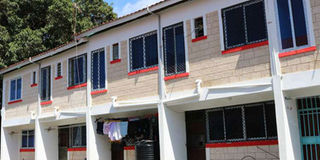Investors turn to budget homes

Some of the budget homes completed and occupied in Mtwapa. Kenya Projects is one investor taking advantage of the gap created by the focus on expensive housing with a Sh4 billion commitment to build affordable houses in Mombasa and Nairobi. PHOTO | EDWIN by OKOTH
What you need to know:
- Mr Kanyi says that in some cases the cost of land per unit sometimes falls as low as Sh100,000, breaking the barrier of high land prices that has been the key determinant of housing prices.
- KCB Mortgage Director Sam Muturi said the strategy is informed by the potential glut in the high-segment market is while the lower segments are locked out of home ownership.
- Kenya Projects has also interested some Brazilian partners, adding to the prospects of not only reaching several other areas, but also reducing the cost of houses.
Investors in real estate are now shifting to budget housing in the face of a market glut in the high-end segment. High mortgage rates and property prices have made matters worse in an industry that has seen an increase in supply and slump in uptake in the last five years, according to real estate experts.
Industry players attribute the low uptake of houses on sale to their high cost, which is beyond the reach of most Kenyans. The scenario has reduced the yields from a sector known for high returns.
Both HassConsult and the Kenya Bankers Association, in their real estate reports for February, noted a decline in yields due to an oversupply in the high-end residential market. Knight Frank, another real estate dealer specialising in the high-end market, has projected a zero rise in house prices.
“With Kenya’s total number of mortgages at 22,000 compared with a population of 44 million, equating to 2.7 per cent of the GDP, Kenya’s mortgage market is still at a very nascent stage compared with more developed housing markets such as South Africa, where mortgages equate to 24 per cent of the GDP,” said Cytonn real estate Chief Investment Officer Elizabeth Nkukuu at the launch of a report last week.
Market players wary of the trend have turned their attention to the lower end of the market, with financiers also monitoring the trend.
Kenya Projects is one investor taking advantage of the gap created by the focus on expensive housing with a Sh4 billion commitment to build affordable houses in Mombasa and Nairobi. The 1,000 houses of different sizes comprising two-bedroom maisonettes will have modest finishes as the developer seeks more land at the lowest possible rates to keep house prices between Sh1.5 and Sh2.5 million per unit.
The project is banking on the high uptake in this segment to deliver the units in Nairobi and Mombasa, with 200 houses already completed and sold in Mombasa’s Mtwapa and Bamburi areas while Ruiru is awaiting the inaugural 100 units of two-bedroom semi-detached maisonettes later this year.
Kenya Projects founder and chief executive David Kanyi told DN2 that the model has been successful, with 60 per cent of the houses having been bought off plan.
“The demand is very high and most of the time we close the sale of a plan on a coconut farm in the case the Mombasa houses. Our focus is on the low-end market, people who want to own basic apartments with standard designs and flexible plans that allow them to make adjustments, like converting the parking into an extra bedroom, or using the balcony as extra space. The market has been skewed in favour of high-end housing but we discovered that many people were willing to forego fancy finishes and huge gardens to achieve the dream of owning a house, “Mr Kanyi said.
Dubbed “budget homes”, the investment model seeks to buy land at the lowest possible rates, with eyes trained on those being auctioned by banks. The model is also relatively cheaper because to the economics of scale, with both suppliers and contractors providing favourable rates due to the magnitude of the projects.
Mr Kanyi says that in some cases the cost of land per unit sometimes falls as low as Sh100,000, breaking the barrier of high land prices that has been the key determinant of housing prices.
NEED FOR SUPPLY
The houses come in different sizes, with the Sh2.5 maisonettes measuring about 120 square feet requiring a Sh1.2 million deposit as the buyer waits eight months for it to be completed. The design, which has an attic, allows for adjustments later.
The Sh1.5 million houses measuring 80 square feet have similar features but do not have an attic. However, the parking space is placed in such a way that it can be converted into a bedroom.
Kenya Projects relies heavily on online marketing and referrals to drive sales, and has received more than 20,000 expressions of interest in various areas. But their requests are still hampered by the availability, and sometimes the cost, of land.
In Nairobi, the firm hopes to get land in areas like Ongata Rongai, Ruai and around Mombasa Road. Meanwhile, in Mombasa, the Shanzu and Mkomani areas have also attracted a number of enquiries.
“While we want to satisfy the demand for affordable houses, sometimes it is almost impossible because the price of land is prohibitive. I hope the government will be able to deal with the speculative nature of land acquisitions. We also have challenges getting skilled labour. Since many technical institutions were upgraded to universities, there is no one to do the plumbing and electrical work; everyone is wither an engineer or an architect,” Mr Kanyi said.
The model has also attracted investors seeking to make profits, who rent out the units in Mtwapa for Sh15,000 a month. Meanwhile, some people who bought the Sh1.6 million houses last year subsequently sold them for Sh2.5.
Banks and foreign investors have become interested in the model as well, creating the prospect of scaling up in other towns across the country.
In fact, the Kenya Commercial bank greatly supports lending for the construction of low-cost housing. The bank will next month launch a property centre to serve as its construction arm.
KCB Mortgage Director Sam Muturi said the strategy is informed by the potential glut in the high-segment market is while the lower segments are locked out of home ownership.
KCB has other initiatives and offers an enhanced product proposition. These efforts have seen the lender partner with Chloride Exide, East African Cables, and Crown Paints to enable customers to get building accessories at discounted prices.
we understand it well and know there is a need for supply in the budget segment,” Mr Muturi told DN2.
KCB has other initiatives and offers an enhanced product proposition. These efforts have seen the lender partner with Chloride Exide, East African Cables, and Crown Paints to help customers get building accessories at discounted prices.
Kenya Projects has also interested some Brazilian partners, adding to the prospects of not only reaching several other areas, but also reducing the cost of houses.
The firm says government intervention in expanding infrastructure outside the metropolitan areas will create interest outside the areas where land is expensive and lower the cost of acquiring a house.
Cytonnn analysts say the recent emergence of REITs in Kenya will also be critical in providing more housing as it will bring in more institutional capital that can finance the development of rentals.
The glut in the upper market has seen many developers facing with lowered occupancy, yet the market has a tradition of not lowering prices.





